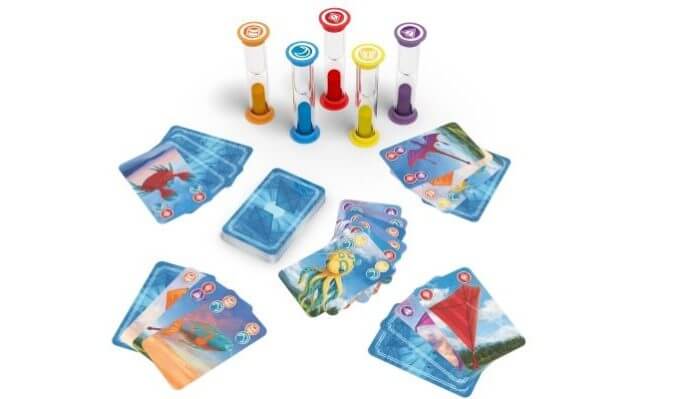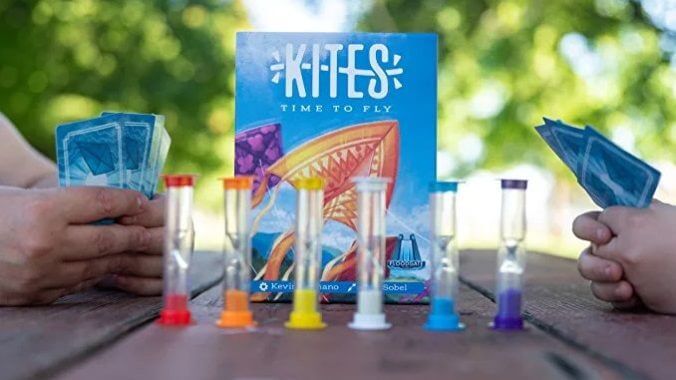Real-time games are a tough category for the tabletop, because they often require a lot of dexterity, which puts a lot of players at a disadvantage or keeps them out of the game entirely. Galaxy Trucker is one that does it well with its real-time scramble to grab parts for your spaceship, which you can easily do on the floor or a small table that allows players to reach the pile. Kites is a new real-time, cooperative game that also keeps things pretty accessible, as players work to play cards from their hands to prevent any of the game’s six sand timers from running out.
Kites is an incredibly simple design at its core. There’s a deck of cards, each of which has the image and symbol of one or two kite colors. There are six sand timers, five of them matching the kite colors from the cards and one “wild” white timer. Players start the game with a hand of three to five cards, depending on the player count. On your turn, you must play one card from your hand, turn over the timer(s) shown on it, and draw a new card. If you play a card with just a single kite on it, you may choose to flip the white timer instead of the one shown, but if you play a card with two kites on it, you must flip both of those timers. Each player is supposed to flip their own timers—you play a card, you flip one or two timers yourself. If any of the six timers runs out, the game ends immediately and the players lose. Once the deck is exhausted, players must continue playing cards and flipping timers, but they may no longer flip the white timer for any reason. If the players play all their hand cards without any timer running out, they win.

Kites is easy to lose and difficult but not impossible to win. The timers all have different durations, ranging from red (30 seconds) to purple (90 seconds), and the shorter a timer’s duration, the more its color appears in the deck. After a few plays, you start to adjust a little bit to understand that the red and orange timers will require more of your attention. You can also lose in just a few turns because the red timer runs out before enough red cards appear, or because two players next to each other didn’t have any red cards. It’s harder with more players because your hand size is smaller; with five to six players, your hand size is three, and thus it’s quite likely that you’ll have two consecutive players without a certain color.
The game also comes with three types of challenge cards, four of each; you pick one challenge and shuffle those four cards into the main deck. When someone draws a challenge card, they must play it on their next turn. Airplane cards require players to stay silent for an entire round, until the player who played it plays their next card. Storm cards mean players must flip all six sand timers. Crossed Lines cards are the biggest hassle, as all players must immediately swap one card with the player on their left and one card with the player on their right, which takes a lot of time when the timers are busy draining.
I love the elegance of the basic game, without the challenge cards. I could teach this game to anyone in just a few minutes—and I have, to people ranging from age six to age 76. There is a little dexterity involved in reaching into the table and turning over the correct timer(s), although pretty much everyone I’ve ever played with has knocked over the wrong timer at least once or twice. You would have to accommodate some players with disabilities, but could easily do so by having one player flip timers for another player who was unable to do so themselves. Beyond that adjustment, you could really play this with anyone who could understand the rules about single and double cards. It’s a great one to get a bunch of folks around a coffee table and find yourselves yelling and laughing within a few minutes, even before you get to the irrationally great feeling of finishing the whole game.
Keith Law is the author of The Inside Game and Smart Baseball and a senior baseball writer for The Athletic. You can find his personal blog the dish, covering games, literature, and more, at meadowparty.com/blog.

